
Watermarks in Incunabula printed in the Low Countries (WILC)
Introduction
Explanations and notes on the website
General
No more than 800 of the about 2000 fifteenth-century editions printed on paper in the Low Countries are dated. Paper research can - as can printing type - provide a dating within a range of years rather than decades. Identification of paper stocks however, has long been hindered by inadequate reproduction of the watermarks used in them. Until halfway the twentieth century, watermarks were reproduced with tracings. But in the second half of the twentieth century, other methods were developed such as photography, beta radiography, Dylux, low-voltage Röntgen radiation (as in WM I 00152), rubbings (as in WM I 00259) and electron radiography.
The two methods here used for the Low Countries incunabula are rubbings and electron radiography. Making rubbings is cheap and quick and does not damage the books. It can be done in every library, an essential advantage since almost 600 editions are found in unique copies in libraries across the world. Of the 2000 editions - with the exception of some 30 mostly thin books - more than 18,000 rubbings of watermarks have been made in one or more copies of each incunable.
The best images of watermarks are made by beta radiography and electron radiography. Because of the slowness of beta radiography - a single image can take hours to capture - electron radiography is preferable. This method was developed almost twenty years ago by Schnitger, Ziesche and Mundry in Berlin and has been adopted in The Hague in cooperation with the Röntgen Technische Dienst (RTD) in Rotterdam. It was possible to make 250 to 300 Röntgen negatives of watermarks from 40 incunabula in four hours in the basement of the Koninklijke Bibliotheek.
The first electron radiographs of watermarks in Low Countries incunabula were taken from more than 100 dated folio editions in the collection of the Koninklijke Bibliotheek (the total of dated incunabula from the Low Countries in folio format is less than 200). To these have been added 22 dated and undated editions from the Museum Meermanno-Westreenianum in The Hague, one from the Koninklijk Huisarchief also in The Hague, one from the Librije in Zutphen and one from the Museum Catharijneconvent in Utrecht. There are also a few images of watermarks found in quartos by the Printer of the Freeska Landriucht (e.g., WM I 00081 - 00098), although a disadvantage with quartos is that the watermark is in the fold of the sheet. Then part of the image, placed as it is on two leaves, is lost in the gutter of a bound volume. A few images of the watermarks in the two blockbooks (Apocalyps and Biblia pauperum) in the KB collection are also included in WILC. The total of records is more than 16.000, almost all accompanied by images.
The content of WILC is also included in the general watermark website The Memory of Paper that has been build in the European Project Bernstein (2006-2009). In Bernstein watermark databases with watermarks taken from objects of different periods, different areas and different materials: manuscripts, printed books, drawings, etchings, prints and maps are integrated and can be searched together. In WILC, more specific search possibilities for incunabula are offered.
Reproduction methods (a selection of images)
| One of the incunabula listed in Incunabula printed in the Low Countries. ILC lists 2229 editions in over 14.300 copies preserved in libraries, archives, museums and some private collections throughout the world. | 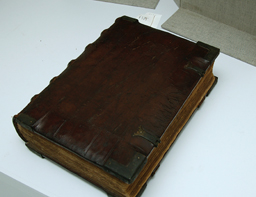 |
| All incunabula printed on paper contain watermarks. Often it is difficult to discover them without the help of special techniques. | 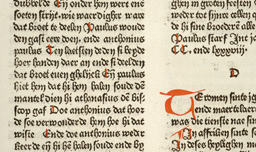 |
| This photograph is made with a light box. The watermark is transparent. A cheaper and faster method is making rubbings. | 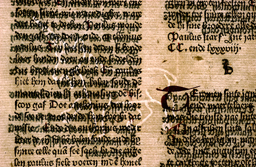 |
| A paper researcher making a rubbing. All one needs is a pencil and a thin piece of paper. Under the leaf there is a plate of perspex as a stable base. | 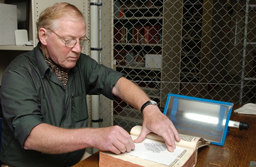 |
| On the paper appears a copy of the watermark. Because this is a folio, the watermark is in the middle of the leaf. In quarto’s, octavo’s, etc,- parts of the same watermark should be rubbed from different leaves. | 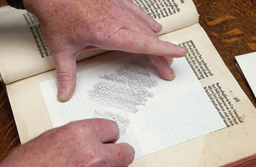 |
| The rubbing of the unicorn is finished. The rubbings are numbered. The leafs where the reproduction originates from are also written on the rubbings. Over 18.000 rubbings are made. They are used to determine whether the watermarks in an incunable are the same or different. If there are more of the same watermarks in an incunable, only one is used for the database. In the database are about 12.000 rubbings. | 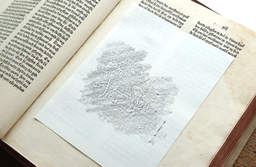 |
| The best images of watermarks are made by electron radiography. In the process of electron radiography, x-rays irradiate a lead foil and produce electrons. These electrons pass through the paper and are absorbed differently according to the density or structure of the paper. The differential absorption is recorded on a sheet of film placed beneath the paper. On the leaf, containing a watermark that has to be reproduced, a lead foil is placed. | 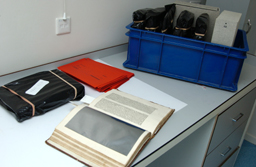 |
| In the darkroom, photosensitive films are placed on the other side of the selected leafs with watermarks. | 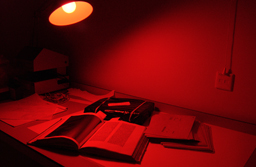 |
| It is possible to make more pictures from one incunable at the same time. The incunable is wrapped to avoid contact with daylight. | 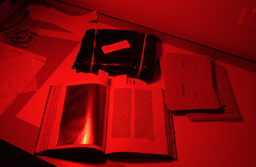 |
| The electron radiographs were made in co-operation with the Röntgen Technische Dienst (RTD) in Rotterdam. http://www.rtd.nl | 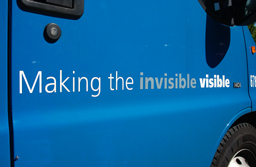 |
| The röntgen negatives were made in the basement of the Royal Library, which was inaccessible during radiography. | 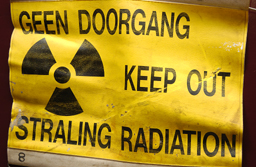 |
| The X-ray tube is placed at the right distance from the incunable. The radiation will activate lead-ions, which go faster through places where the paper is thin. This makes an image of the watermark on the film. | 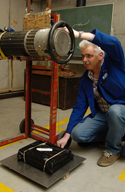 |
| Radiation time and intensity of radiation on the display of the apparatus. | 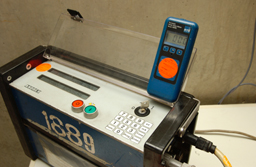 |
| The films are processed by the photographer. | 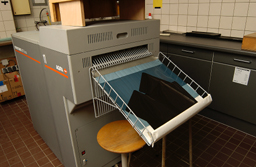 |
| The photographs are checked. | 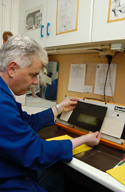 |
| A clear image of a letter p, quatrefoil, to right. | 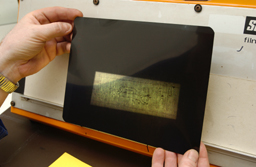 |
| The images are scanned and added to the descriptions of the watermarks in the database. There are over 4300 electron radiographs in the database. |  |
Explanations and notes on the website
See also Help in the frame left and the Help buttons left of the Search Boxes
In the production of fifteenth-century paper two moulds were used, each with a similar but not identical watermark. Every paper stock is identified by a pair of watermarks, or "twins". The twin watermarks in the two moulds are usually in opposite halves of the moulds. The side of a sheet of paper that was in direct contact with the mould (and so with the wires and the watermarks) shows more relief than the other side (the "felt" side) of the sheet. For making rubbings the relief or "mould" side is better and for the same reason the electron radiographs show the mould side of the sheet. Looking at the mould side and placing the watermark in an upright position (only symmetrical watermarks such as star and sun cause problems here) it is possible to describe one of a pair as mark left, the watermark closest to the left short outer side of the sheet, or mark right, the watermark closest to the right short outer side of the sheet. By reproducing the mould side, it is possible with many types of watermarks to reduce the search results by three quarters; for instance, watermark letter p can be split into two groups by its position in the two moulds, mark left and mark right, and these two groups can again be split into mL p to right (reading direction), mL p to left (inverse) and mR p to right (reading direction) and mR p to left (inverse). For identification of watermarks and paper stocks four groups of 25 watermarks will be easier to handle than one of 100. The recording of Twins is not complete.
The main descriptions or names of the watermarks are as in the English Typological Index in the 1968 edition of Briquet. The only exception is that lily is preferred to fleur-de-lis. The 39 group names (from acorn to wheel, ending with a miscellaneous group) can be found under Structure Search. Clicking on an entry will open a subgroup, that may be further divided as can been seen when clicking on the name of the subgroup. The subgroups follow partly their own system: the larger the main group, the more subgroups will branch from it. The large main groups are bull, dog, hand, pot and the two main groups with the most records letter p and shield. In the last no heraldic terms have been used with the exception of bends, the direction of the bends being indicated by / or to differentiate further between subgroups. When a subgroup is not further divided, an attached image is shown. By clicking on the arrow next to a subgroup, the item will be searched.
Chainlines: the two digits denote the chainlines (counted from the outside of the sheet) between which the watermark is found. Tranchefiles and chainlines may have been cropped by the binder. The height of the watermarks is measured only in folio editions.
The density of laid lines has been added since October 2003 as an extra parameter. Irregularities of the paper sheets and differences in thickness of the chainlines, the lines of the watermark itself and the density of laid lines render exact measurement of the distance between chainlines and height WM difficult. Searching with a margin of 1 mm on either side is recommended; this may be done by using entering in the search box the two values, separated with a space.
Mainclass IPH (International Association of Paper Historians). Notice has been taken of the International Standard for the registration of papers with or without watermarks, Typological Index, Version 2.0 (1997). Only the letters of IPH's main classes have been given. Its subclasses are inadequate for the differentiation of WILC's subgroups; for instance, IPH bull, 3 subclasses, WILC 23 subgroups, IPH dog, no subclass, WILC 18 subgroups, IPH letter p, 3 subclasses, WILC 52 subgroups.
The main classes of IPH are:
| A | Human figures; men; parts of the human body |
| B | Women |
| C | Mammals |
| D | Birds |
| E | Fish, reptiles, insects, molluscs |
| F | Mythical figures |
| G | Plants (general); flowers; grass |
| H | Trees; shrubs; creepers |
| J | Sky, earth, water |
| K | Buildings, parts of buildings |
| L | Transport, vehicles |
| M | Defence and arms |
| N | Tools, equipment, clothing |
| O | Musical instruments |
| P | Containers |
| Q | Miscellaneous objects |
| R | Insignia of rank, sceptre, mace, jewellery |
| S | Religious or magic symbols and signs |
| T | Heraldry, coats of arms, mason's marks, trademarks |
| U | Geometric figures |
| V | Numbers, numerals |
| W | Individual letters |
| X | Monograms, abbreviations with letters |
| Y | Names (in full) |
| Z | Unclassifiable watermarks |
For more information see the IPH website.
This website is not intended as a gallery of unique watermark images but as a tool for the better dating of incunabula. For that reason images of the same watermark in different editions are given. These are called equivalents and are brought together in equivalents groups.
All places of printing and printers of the Low Countries are in the Indexes
With the incunables drawn upon for the watermarks, a distinction is made between a date of printing in the book itself, and a deduced date based on type, woodcut or paper evidence.
Under paper size the standard is Chancery, but there are also some watermarks from incunabula printed on two other sheet sizes of the fifteenth century: Median and Royal; Imperial paper is not represented. The dimensions for these four sizes are: Imperial ca. 49 x 74 cm, Royal ca. 43 x 62 cm, Median ca. 35 x 51 cm and Chancery ca. 32 x 45 cm.
To identify the incunabula, the imprint - place, printer, date - is given, and also the institution and the shelfmark of the copy used, followed by two bibliographical references: Incunabula printed in the Low Countries (ILC) and Campbell's Annales (CA, Camp). Author neither titles are given; these can be easily found by clicking the direct link to ISTC.
Technical specifications
The first website was built by the KB and was published in 2000. The watermark database was constructed with Microsoft Access 97. In 2011-2012 the website was rebuilt using XML and Lucene / SolR indexing. The electron radiographs of the watermarks were scanned at 600 dpi and saved in jpg format for the master images. The jpg images on de website have been compressed to 150 dpi.
WILC as open data set
Data services are services for premitting automated use of the KB’s data. Digital illustrations, metadata and texts can be made available via an API (Application Programming Interface) using SRU or OAI-PMH, and may be combined with other data to make new research, web applications and services possible.
The KB has waived its copyright on the metadata for this set, which, therefore, has a CC0 licence. The KB has also waived its copyright to the objects (illustrations of watermarks) in the WILC set, which, therefore, also have a CC0 licence. This means that there are no copyright restrictions on reproducing, publishing, processing or sharing these illustrations.
Although there is no requirement to credit the source when using the set, the KB would be grateful for this. Please use the following text:
National Library of the Netherlands, The Hague. Source: http://watermark.kb.nl - [link to object].
The KB asks anyone who uses the digital watermarks in this set to respect the Europeana Usage Guide for public domain works.
The following files are available for the watermarks in the WILC set:
• an illustration of the watermark (JPG), usually about 400 x 600 pixels (exact dimensions vary from scan to scan);
• descriptive metadata (Dublin Core in XML) with permanent links to the above illustrations.
The metadata and digital objects in the set are a total of 1.7 GB.
For technical information and more explanation, please consult the dataservices page of the KB and the WILC-section at this page.
Bibliography
Watermark repertories
C.M. Briquet, Les filigranes. The new Briquet-Jubilee edition, edited by Allan Stevenson. Amsterdam 1968, 4 vols.
Gerhard Piccard, Die Wasserzeichenkartei Piccard im Hauptstaatsarchiv Stuttgart. Stuttgart 1961-1997, Findbuch I-XVII, 25 Bnde.
Articles on watermarks in Low Countries incunabula
Gerard van Thienen, 'Papieronderzoek van de in de Nederlanden gedrukte incunabelen', in : Anton Gerits (ed.), For Bob de Graaf, antiquarian bookseller, publisher, bibliographer. Amsterdam 1992, pp. 160-173 (With references to the earlier literature on paper and watermark research of Low Countries incunabula). Full version see: http://www.bibliopolis.nl
Gerard van Thienen, 'Boeken van papier en hun watermerken', in: Jos. M.M. Hermans and Klaas van der Hoek (ed.), Boeken in de late Middeleeuwen. Groningen 1992, pp. 167-182.
Gerard van Thienen, 'Die Datierung der Werke des 'Druckers mit dem Monogramm' (Utrecht 1479-1480) nach dem Papierverbrauch', in: Johannes Gutenberg - Regionale Aspekte des frühen Buchdrucks. Berlin 1993, pp. 193-202.
Elly Cockx-Indestege, Gerard van Thienen and Jean Gustin, 'Le Missale leodiense imprimé par Jean de Westphalie', in: Bulletin de la Société des Bibliophiles liégeois 23 Liège 1997, pp. 19-85.
Gerard van Thienen, 'A date for the Freeska Landriucht press (1484-7) from paper evidence with a note on the Codex Roorda', in: Martin Davies (ed.), Incunabula, studies in fifteenth-century printed books presented to Lotte Hellinga. London 1999, pp. 141-167.
Gerard van Thienen, 'Papieronderzoek en de drukpers van de Broeders des gemenen levens in Brussel (1475-1485)', in: E Codicibus Impressisque, Opstellen voor Elly Cockx-Indestege. Leuven 2004, I, pp.431-454.
Gerard van Thienen, 'Papieronderzoek van de in de Nederlanden gedrukte incunabelen, zie 'www.kb.nl/watermark', in: Boek & letter, Boekwetenschappelijke bijdragen t.g.v. het afscheid van prof.dr. Frans A. Janssen als hoogleraar in de Boek-en bibliotheekgeschiedenis aan de Universiteit van Amsterdam, red. Jos Biemans, Lisa Kuitert & Piet Verkruijsse. Amsterdam 2004, pp. 31-46.
Paul Needham, 'IDL, ILC, WILC: Gerard van Thienen's contributions to the study of incunabula', in: Quaerendo 36,2006,pp.3-24. (With an extensive evaluation of WILC).
Gerard van Thienen und Martine Veldhuizen, 'Watermarks in Incunabula printed in the Low Countries (WILC), An online illustrated database', in: Piccard-Online, Digitale Präsentationen von Wasserzeichen und ihre Nutzung. Hrsg. Peter Rückert, Jeannette Godeau, Gerald Maier. Stuttgart 2007, pp.65-69.
Peter Rückert e.a. Bull's Head and Mermaid. The History of Paper and Watermarks from the Middle Ages to the Modern Period. Stuttgart and Vienna 2009. Exhibition Catalogue with contributions on WILC and paper research by Marieke van Delft and Gerard van Thienen. This catalogue was also published in German and Spanish, with updates about certain subjects.
Marieke van Delft, 'Using watermarks to ascribe printed books: WILC and Delft printing', in: Martin Haltrich und Maria Stiegelecker (Red.). Code(x): Festgabe zum 65. Geburtstag von Alois Haidinger, p. 36 - 49, ill. (Speciale aflevering van: Codices Manuscripti (2010). Supplementum 2).
Marieke van Delft, ‘Watermarks in Incunabula printed in the Low Countries (WILC) and Piccard-Online: a comparison of two important watermark databases and research prospects for combining their data’, in: Wasserzeichen und Filigranologie. Beiträge einer Tagung zum 100. Geburtstag von Gerhard Piccard (1909-1989). Stuttgart 2011, p. 90 – 100
Some other publications on watermarks
Dierk Schnitger, Eva Ziesche and Eberhard Mundry, 'Elektronenradiographie als Hilfsmittel für die Identifizierung schwer oder nicht erkennbarer Wasserzeichen, in: Gutenberg Jahrbuch 58.Mainz 1983, pp. 49-67.
Stephen Spector (ed.), Essays in Paper Analysis. Washington 1987.
Monique Zerdoun Bat-Yehouda avec la collaboration de Georges Korobelnik, Les papiers filigranés médiévaux. Essai de méthodologie descriptive. Vols I and II. Turnhout 1989, Bibliologia 7, 8.
Theo Laurentius, Harry M.M. van Hugten, Erik Hinterding and Jan Piet Filedt Kok, 'Het Amsterdamse onderzoek naar Rembrandts papier: radiografie van de watermerken in de etsen van Rembrandt', in: Bulletin van het Rijksmuseum, veertigste jaargang. Amsterdam 1992, pp. 353-384.
Paul Needham, 'Allan H. Stevenson and the Bibliographical Uses of Paper', in: David L. Vander Meulen (ed.), Studies in Bibliography, Volume Forty-Seven. Virginia 1994, pp. 23-64.
Paul Needham, 'Res papirea: Sizes and Formats of the Late Medieval Book', in: Peter Rück (ed.), Rationalisierung der Buchherstellung im Mittelater und in der frühen Neuzeit, Ergebnisse eines buchgeschichtlichen Seminars Wolfenbüttel 12. - 14. November 1990. Marburg an der Lahn 1994, pp. 123-145.
Puzzles in Paper, Concepts in historical watermarks, ed. by Daniel W. Mosser, Michael Saffle & Ernest W. Sullivan.
New Castle, USA/London, 2000.
Martin Wittek, Inventaire des manuscrits de papier du XVe siècle conservés à la Bibliothèque royale de Belgique et de leurs filigranes. Tome III: Manuscrits datés (1461-1480). Préf. Raphaël de Smedt. Bruxelles 2005, 2 T.
Wittek: Tome IV (1481-1500). Bruxelles 2006.
See also the Bibliography in Bernstein, that contains more than 31,000 bibliographic records on paper and paper history.
Bibliographical reference works of incunabula
Gerard van Thienen & John Goldfinch, Incunabula printed in the Low Countries. A Census. Nieuwkoop 1999.
M.F.A.G. Campbell, Annales de la typographie Néerlandaise au XVe siècle. La Haye 1874, suppléments I-IV 1878-1890.
Ina Kok, Woodcuts in incunabula printed in the Low Countries. Houten, HES/De Graaf 2013. 4 vols.
Updates
2004:
The number of images has increased to more than 16.000. The electron radiographs and rubbings are taken not only from dated books in folio format but also from smaller format incunabula and from copies in more than 200 collections other than the Koninklijke Bibliotheek.
Thanks to Vlad Atanasiu an extra parameter could be added: the Density of laid lines. See: http://www.bernstein.oeaw.ac.at/ad751/
2007:
In the Bernstein Project, a link has been established between WILC and The Incunabula Short Title Catalogue (ISTC) (http://www.bl.uk/catalogues/istc/)
2012:
A new website is released that was build in the Bernstein Project, based on the KB-infrastructure using XML, with new search facilities and indexing (Lucene and SolR).
Koninklijke Bibliotheek - National Library of the Netherlands